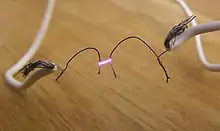电弧
電弧,又稱弧放電,是由于电场过强,气体发生電擊穿而持续形成等离子体,使得电流通过了通常状态下的绝缘介质(例如空氣)的現象,或者说当通电的高电压电路出现导体与导体的分开时,两端就会出现电弧 。

兩支杆之間產生的電弧。

兩根針之間產生的電擊穿現象,電流通過周遭已被離子化的氣體而產生呈帶狀細絲的發光現象。

電擊槍上的電弧。
用途
電弧產生的高熱可以融化或是汽化所有的金屬[1],工業上利用電弧來焊接、融化或是切割金屬,例如電漿切割機、放電加工機、煉鋼廠的電弧爐。常見於電銲,氬焊。在汽機車修理,板金,車床。
電弧燈、電影院用的電影放映機也是利用電弧原理的一些設備。
1808年漢弗里·戴維(Humphry Davy)利用此一現象發明第一盞「電燈」—電弧燈。
参考文献
- Carbon arc melting (页面存档备份,存于).
- unintentional arc 的存檔,存档日期2005-07-31.
- . [2007-06-14]. (原始内容存档于2007-06-13).
- . [2023-07-30]. (原始内容存档于2023-05-22).
- . [2023-07-30]. (原始内容存档于2023-07-21).
- . [2023-07-30]. (原始内容存档于2023-05-19).
外部參考
This article is issued from Wikipedia. The text is licensed under Creative Commons - Attribution - Sharealike. Additional terms may apply for the media files.
